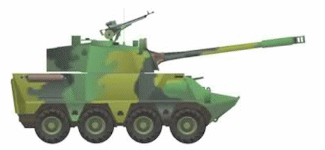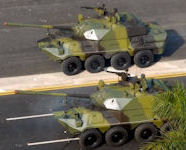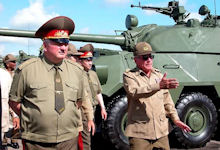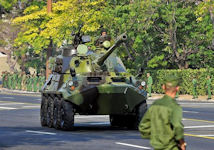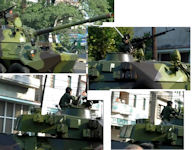BTR-100 - BTR-60 100mm T-54/55 turret
Recent wars have shown that the fiercest fighting occurred in urban areas, not in the jungle or desert as in the old view. Besides, the combat in urban areas also proved to be the method to consume the forces of the most attacking side, rather than the old way of taking advantage of the rugged terrain to engage in melee due to the main weapons. High corpses have erased this limit. In the world, the means for urban warfare are becoming more and more developed, besides armored vehicles, infantry fighting vehicles, tire tanks are the most powerful weapons due to it. only having to move in places where the terrain is flat, the roads are good, so it does not require a traditional crawler tank.
The reason for such vehicles is simple. A wheeled vehicle is much cheaper than a tracked vehicle. And the damage it causes is equal to the tank. Which is more vulnerable? In 1991 it was found that T-55 tanks were easily destroyed by Western tanks. Even for the Bradley 25mm guns. Almost always, with total loss of the crew. Given that, there is not much difference with what would happen with a wheeled APC, with the advantage of speed and fuel economy of the BTR.
Due to difficulties in procuring and equipping new weapons due to the sanctions imposed by the US and the collapse of the Soviet Union leading to the loss of vital aid, the Cuban Army overcame difficulties. by conducting upgrades, converting many old weapons to give them an outstanding power. An example of Cuba's weapons hybrid may include the SA-2/3 anti-aircraft missile launchers mounted on the T-54/55 tank chassis, bringing up 122/130/152 mm guns on wheeled trucks. However, the project was the most successful evaluation of the conversion of armored vehicles carrying BTR-60 into infantry fighting vehicles by integrating the 73-mm turret of BMP-1, or turning them into "tanks" when attaching a 100 mm turret of T-54/55.
In order to carry out this modification, the BTR-60 armored vehicle removed the 14.5 mm turret to replace it with a turret modified from a T-54/55 tank with a 100 mm D-10T2S cannon. When implementing this upgrade and conversion program, the engine must be forward, BTR-60 is no longer able to swim like the original as well as losing the function of carrying troops. The Cuban Army's new vehicle is rated capable of being deployed in urban combat as a firepower support vehicle with US similar M128 M1 Stryker MGS, while its anti-armor function remains preserved.
The main drawback of BTR-60 is that the engine is positioned behind the vehicle like a tank, so the infantry is forced to exit and exit by the door. However, if the BTR-60 chassis is modified by attaching the 100-mm D-10T2S gun turret of T-54/55 or the T-62 U-5TS 115 mm, it accepts the removal of soldier carrying capacity and ability to swim, it provides a wheeled "tank" with firepower no less than anyone.
The center of gravity shift and the weight of the gun (around 10 tons) assure that the performance of the vehicle will be abysmal and reliability very low. Its a typical example of war-time rigging. Although it was judged to be successful, but following the development momentum, when other countries produced many large-wheeled wheeled tanks, the firepower of BTR-60 with a 100 mm cannon proved to be limited, therefore, the need to upgrade and replace has become urgent.
|
NEWSLETTER
|
| Join the GlobalSecurity.org mailing list |
|
|
|


